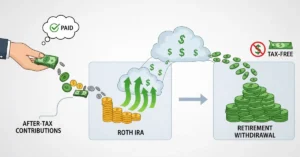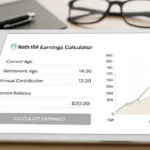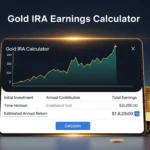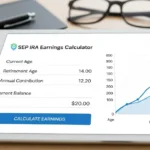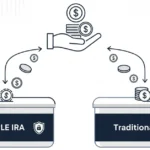Welcome to smartretireplans.com!
If you’re a freelancer, a contractor, or a small business owner, you already know that being your own boss comes with a unique set of challenges and opportunities. One of the biggest opportunities is building a robust retirement plan that offers significant tax advantages. You’ve likely heard about the Simplified Employee Pension, or SEP IRA, and the question on your mind is probably the most important one:
“Are SEP IRA contributions tax-deductible for the self-employed?”
The short, powerful answer is yes, absolutely.
A SEP IRA is a retirement plan designed specifically for self-employed individuals and small business owners, and its primary benefit is that the contributions you make are a direct deduction from your taxable income. This means you can save for your future and significantly lower your tax bill at the same time.
But the story doesn’t end there. The beauty of the SEP IRA is in its simplicity and its generous contribution limits. In this comprehensive, human-friendly guide, we will unpack everything you need to know, including:
- Exactly how the tax deduction works and how it can save you money.
- The high-powered contribution limits for 2025 and beyond.
- A step-by-step example of how to calculate your maximum deductible contribution.
- How a SEP IRA stacks up against other popular retirement plans like the Solo 401(k).
- All the key rules and deadlines you need to know.
Let’s dive in and learn how to use a SEP IRA to build a powerful, tax-efficient retirement.
Part 1: The Basics – What is a SEP IRA and How Does it Work?
Before we get into the nitty-gritty of the tax deduction, let’s quickly define what a SEP IRA is.
A SEP IRA is a retirement plan that allows self-employed individuals and small business owners to make contributions to a retirement account on behalf of themselves and their employees. The “SEP” stands for Simplified Employee Pension, and the “IRA” stands for Individual Retirement Arrangement. The combination of these two means you are setting up individual retirement accounts for everyone in your business, funded solely by the employer (you).
Key Features of a SEP IRA:
- Simple to Set Up: A SEP IRA is one of the easiest retirement plans to establish. You typically only need to fill out a one-page form (Form 5305-SEP) and open an account with a financial institution.
- Employer-Funded Only: Unlike a Traditional or Roth IRA, only the employer (the business owner) can contribute to a SEP IRA. The employee (including the owner) cannot make their own elective salary deferrals.
- Flexible Contributions: You are not required to contribute every year. You can decide each year whether you want to contribute and at what percentage, based on your business’s profitability. This flexibility is a huge advantage for businesses with unpredictable income.
- High Contribution Limits: This is where the SEP IRA truly shines. The amount you can contribute is significantly higher than a traditional or Roth IRA.
Part 2: The Tax Deduction Explained
For the self-employed, a SEP IRA is a triple-threat tax-saver. It reduces your income tax, lowers your self-employment tax, and allows your money to grow tax-deferred.
How the Tax Deduction Reduces Your Income Tax
When you contribute to a SEP IRA, the entire amount is considered a business expense. On your personal income tax return (Form 1040), you will take a deduction for the total contribution you made for yourself. This deduction is an “above-the-line” deduction, meaning it lowers your Adjusted Gross Income (AGI) and, as a result, reduces your income tax liability.
Think of it this way: If you earn $100,000 in net income and contribute $20,000 to your SEP IRA, the IRS only sees $80,000 of income to tax. This immediate tax savings can be substantial, especially if you are in a higher tax bracket.
How it Lowers Your Self-Employment Tax
This is a lesser-known but equally important benefit. For a self-employed individual, your Social Security and Medicare taxes are calculated based on your “net earnings from self-employment.” When you contribute to a SEP IRA, your net earnings are reduced, which in turn slightly reduces your self-employment tax bill. While the savings aren’t as dramatic as the income tax deduction, every dollar counts.
Tax-Deferred Growth
Just like a Traditional IRA, the money you contribute to a SEP IRA grows tax-deferred. This means you don’t pay taxes on any of the investment gains—dividends, interest, or capital gains—until you start taking withdrawals in retirement. This compounding growth, free from the drag of annual taxes, is a powerful engine for long-term wealth creation.
Part 3: Contribution Limits & How to Calculate Your Deduction
The high contribution limit is one of the most attractive features of a SEP IRA. However, for a self-employed individual, the calculation can be a bit tricky.
The Limits for 2025
For the 2025 tax year, the maximum amount that can be contributed to a SEP IRA is the lesser of:
- 25% of an employee’s compensation or
- $70,000
This limit applies to the total amount contributed on behalf of each individual, including yourself. There are no “catch-up” contributions for those aged 50 or older, as contributions are made by the employer, not the employee.
The Special Calculation for the Self-Employed
For the self-employed, the calculation is not as simple as taking 25% of your net business income. The IRS has a special rule because your contribution is considered a business expense that reduces your compensation. This creates a circular reference that requires a specific calculation.
The IRS essentially says that a self-employed person’s “compensation” for SEP IRA purposes is their net earnings from self-employment after deducting:
- One-half of the self-employment tax.
- The contribution to your own SEP IRA.
This effectively lowers the contribution rate from 25% to 20% of your net earnings before these deductions.
Here’s the step-by-step process for a sole proprietor:
- Calculate Your Net Earnings: This is your gross business income minus all your business expenses. You’ll find this number on your Schedule C.
- Calculate Your Self-Employment Tax: Use Schedule SE to calculate your self-employment tax.
- Subtract Half of Your Self-Employment Tax: Take your net earnings and subtract half of the self-employment tax.
- Multiply by the Adjusted Contribution Rate: Take the result from Step 3 and multiply it by the effective contribution rate of 20% (or 0.20).
Let’s look at a concrete example to make this crystal clear.
A Practical Example
Let’s say you are a self-employed consultant with the following numbers for 2025:
- Gross Business Income: $150,000
- Business Expenses: $30,000
- Net Business Income (pre-tax): $120,000
- Calculate Net Earnings: $120,000.
- Calculate Self-Employment Tax: Your self-employment tax is based on your net earnings. Let’s assume this is approximately $16,950.
- Subtract Half of Self-Employment Tax: $120,000 – ($16,950 / 2) = $111,525.
- Calculate Your SEP Contribution: $111,525 x 20% = $22,305
In this example, you can contribute and deduct $22,305 to your SEP IRA. That is $22,305 that is shielded from income tax for the year.
Part 4: SEP IRA vs. Solo 401(k) – A Quick Comparison
When you’re self-employed, the SEP IRA isn’t your only option. The Solo 401(k) is another powerful retirement plan that is often compared to a SEP IRA. Understanding the differences is crucial for choosing the right plan for you.
| Feature | SEP IRA | Solo 401(k) |
| Who Can Contribute | Employer (you) only | Employer (you) AND Employee (you) |
| Contribution Type | Employer contributions only | Employee deferrals & Employer profit-sharing |
| Annual Limit (2025) | Lesser of 25% of comp or $70,000 | Lesser of 100% of comp or $70,000 |
| Catch-up Contributions (Age 50+)? | No | Yes (up to $7,500) |
| Roth Option? | No | Yes |
| Loan Provision? | No | Yes |
| Administrative Simplicity | Very Simple | Simple, but requires more paperwork |
Key Takeaways from the Comparison:
- Higher Contribution Potential (at lower income): A Solo 401(k) often allows you to contribute more at lower income levels because you can make an employee contribution. For instance, in 2025, you can contribute up to $23,500 as an employee, even with minimal business income, which is not possible with a SEP IRA.
- Flexibility: The Solo 401(k) is more flexible with its Roth option and loan provisions. The Roth option is a huge benefit for those who expect to be in a higher tax bracket in retirement.
- Administrative Ease: The SEP IRA is the clear winner for simplicity. You can set it up quickly and easily with no ongoing administrative burden. A Solo 401(k) requires slightly more paperwork, including filing a Form 5500 once your plan assets reach a certain threshold.
When should you choose a SEP IRA? A SEP IRA is often the best choice for small business owners with a few employees, as you must make contributions to all eligible employees at the same percentage as your own. If you have no employees (other than your spouse), the Solo 401(k) often provides more contribution potential and flexibility.
Part 5: Essential SEP IRA Rules and Deadlines
To take full advantage of your SEP IRA, you need to be aware of a few key rules and deadlines.
The Contribution Deadline
This is one of the greatest benefits of a SEP IRA. You have until the due date of your business’s tax return, including any extensions, to make your contributions for the previous year.
- For the 2025 Tax Year: The standard deadline is April 15, 2026.
- With a tax extension: The deadline can be pushed to October 15, 2026.
This gives you a significant amount of time to determine your profitability for the year and make a strategic, tax-deductible contribution.
Rules for Employees
If you are a small business owner with employees, the SEP IRA has specific eligibility and contribution rules you must follow:
- You must offer the plan to all employees who are at least 21 years old, have worked for you for at least three of the last five years, and earned at least $750 in compensation for the year.
- When you make a contribution, you must contribute a uniform percentage of compensation for all eligible employees, including yourself. If you contribute 20% of your own income, you must contribute 20% of each eligible employee’s compensation as well.
Conclusion: Are SEP IRA Contributions Tax-Deductible for the Self-Employed?
The answer is a resounding yes—SEP IRA contributions are tax-deductible for the self-employed, offering a simple yet powerful way to save for retirement and reduce your tax burden.
By understanding the mechanics of the tax deduction, the high contribution limits, and the key rules, you can make a strategic decision that will benefit you for years to come. Whether you’re a freelancer just starting out or a seasoned business owner, the SEP IRA is a retirement plan you should seriously consider.
As with any major financial decision, we always recommend consulting with a qualified financial advisor and tax professional to ensure you are choosing the right retirement plan for your unique situation and maximizing your savings.
FAQ
Are SEP IRA contributions a direct tax deduction?
Yes. Contributions you make to your SEP IRA are fully tax-deductible. The entire amount is treated as a business expense and is deducted from your taxable income for the year, which can significantly lower your tax bill.
What is the maximum amount I can contribute to a SEP IRA?
For 2025, the maximum contribution limit is the lesser of 25% of an employee’s compensation or $70,000. For the self-employed, this translates to an effective rate of 20% of your net self-employment earnings.
What is the deadline for making a SEP IRA contribution?
You have a long time to contribute. The deadline is the due date of your business’s tax return, including any extensions. For the 2025 tax year, this means you can make a contribution as late as October 15, 2026, if you file for an extension.
Do I have to contribute to my SEP IRA every year?
No. One of the great advantages of a SEP IRA is its flexibility. You are not required to contribute every year, and you can change the contribution percentage from year to year based on your business’s profitability.
How does a SEP IRA differ from a Solo 401(k) in terms of tax benefits?
Both a SEP IRA and a Solo 401(k) offer tax-deductible contributions. The key difference lies in the types of contributions. A SEP IRA only allows employer contributions, while a Solo 401(k) allows both employer profit-sharing and employee salary deferrals. This can often result in a higher contribution potential with a Solo 401(k), especially at lower income levels.
Can I make a Roth contribution to a SEP IRA?
No. A SEP IRA is strictly a pre-tax retirement plan. All contributions are made with pre-tax dollars and are tax-deductible. You cannot make after-tax or Roth contributions to a SEP IRA.



